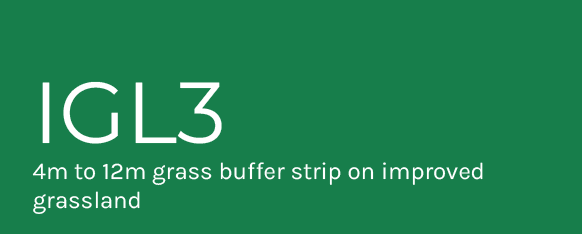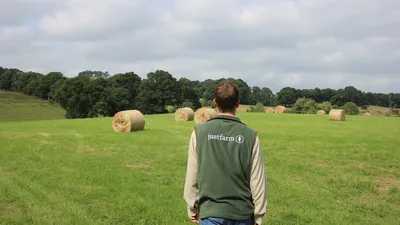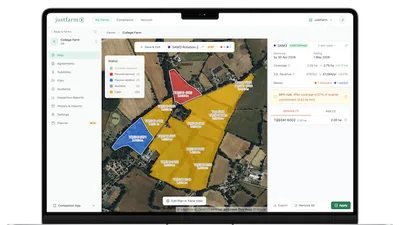IGL3 - 4m to 12m Grass Buffer Strip on Improved Grassland
Payment
You’ll receive £235 per hectare per year for the total area of land you choose to enter into this action.
In your SFI application, you’ll enter the area measurement in hectares for each land parcel. For each buffer strip, measure the length in metres which you want to enter into this action. Multiply that length by the relevant width (which must be 4m to 12m and can vary over the length of the buffer strip) to give you the area in m2. Divide that area by 10,000 to convert it into hectares.
Aim
This action aims to create a grass buffer strip with an intact grass sward throughout the year, without tracks, compacted areas or poaching. The purpose of this is to:
- Protect existing landscape and heritage features.
- Provide habitat for wildlife.
- Prevent pollutants, such as sediment and nutrients, from being carried in surface water runoff, if located next to a watercourse.
Where You Can Do This Action
You can do this action on eligible agricultural land located below the moorland line. The table below sets out what land is eligible for IGL3.
Table 38: Eligible land for IGL3
| Eligible land type | Eligible land use code | Compatible land cover |
|---|---|---|
| Temporary grassland | TG01 | Arable land |
| Improved permanent grassland | PG01 | Permanent grassland |
The glossary (annex C) explains what we mean by land types, land use codes and compatible land covers.
The SFI application service will automatically calculate what area may be eligible for this action in each land parcel. This is called the ‘SFI available area’. You must check this area is an eligible land type. Find out how the SFI available area is calculated in the information on land that’s eligible for the SFI actions (section 4.1.2).
You can apply for this action on either the total SFI available area in each land parcel shown in your SFI application, or part of that area. However, this action is normally intended to be done on part of a land parcel as a field corner or block.
This action is static. You must do this action on the same area of eligible land each year of your 3-year SFI agreement. You cannot move the area each year.
Other Land Management Actions or Options You Can Do on the Same Area as IGL3
The table below sets out which other SFI actions, CS management options, ES revenue options and SFI pilot standards can be located on the same eligible area within a land parcel as IGL3.
Table 39: Actions or options that can be located on the same area within a land parcel as IGL3
| Scheme | Action or option codes that can be located on the same area as IGL3 |
|---|---|
| SFI 2023 | SAM1, IPM1, NUM1 |
| CS | OR1, OR3, OT1, OT3, SW10, SW17, SW18 |
| ES | No ES revenue options |
| SFI pilot | No area-based SFI pilot standards |
Use the CS grant finder to search for the CS option codes shown above.
The SFI actions for hedgerows (HRW1, HRW2 and HRW3), CS option BE3 and the introductory level of the SFI pilot hedgerows standard can be done on the eligible boundaries of a land parcel entered into IGL3.
If an action or option cannot be located on the same area within a land parcel as IGL3, this is because it’s not an eligible land type, or the activities are incompatible, or you would be paid twice for doing the same activities on the same land. In this case, that area will be automatically removed from the affected land parcel’s SFI available area in your SFI application.
If this is the case, you may be able to do the action on a different area in the same land parcel if:
- it’s an eligible land type for the action or option
- it’s a part-parcel action or option
- the area used for the action or option does not overlap with the area used for IGL3
Read the information about eligibility of land used for other schemes and funding sources (section 4.2) to find out more.
What To Do
You must establish and maintain a grass strip that’s at least 4m to 12m wide (on average in each land parcel) on the edge of improved grassland. It can be more than 12m wide, but you’ll only be paid for the 12m width.
It must buffer an existing landscape feature, or certain heritage features, such as:
- hedgerows
- stone walls
- woodland
- ditches, rivers and streams
- upstanding historic or archaeological features, such as earthworks, in-field structures or buildings
You can also locate the grass buffer strip next to:
- trackways that channel run-off water directly into a watercourse
- fence lines that form links between areas of wildlife habitat
The buffer strip for this action must be in addition to any regulatory requirements relating to buffer strips and green cover. For example, it must be in addition to GAEC1: Establishment of buffer strips along watercourses and GAEC7a: Boundaries under the cross compliance rules, which will continue to apply until 31 December 2023, and any successor regulatory requirements.
Once established, you must maintain the grass buffer strip. To do this, you must manage it in a way that can reasonably be expected to achieve this action’s aim.
You can graze the grass buffer strip with livestock, provided there’s an intact grass sward throughout the year, without tracks, compacted areas or poaching.
You must not do the following on the grass buffer strip once it’s established:
- cut it for hay or silage, so it can provide a refuge for farmland wildlife
- use it for regular vehicular access, turning or storage
- apply any fertilisers and manures
- use pesticides, except for herbicides to weed wipe or spot treat for the control of injurious weeds, invasive non-native species, nettles or bracken
You can maintain existing grass buffer strips to meet this action if they:
- meet the requirements explained above
- are not already being paid for under another environmental land management scheme agreement, such as CS option SW2 (4m to 6m buffer strip on intensive grassland).
When to Do It
You must:
- establish the grass buffer strip during first 12 months of your SFI agreement
- maintain the grass buffer strip in each subsequent year of your 3-year SFI agreement
How to Do It
It’s up to you how you complete this action, as long as you do it in a way that can reasonably be expected to achieve this action’s aim.
You may find it helpful to read the voluntary guidance on how to establish and maintain a 4m to 12m grass buffer strip, but you do not have to follow it.
What Evidence to Keep
You should keep evidence to show what you’ve done to complete this action. This will help if it’s not clear that you’ve completed the action in a way that could reasonably be expected to achieve this action’s aim. You must supply this evidence if we ask for it.
This evidence could include photographs and other documentation to show what you’ve done to complete this action. It could also include field operations at a land parcel level and associated invoices. If you choose to take photographs, read the guidance on how to take photographic evidence (annex A).
Contains public sector information licensed under the Open Government Licence v3.0. Source: SFI Handbook for the SFI 2023 Offer




